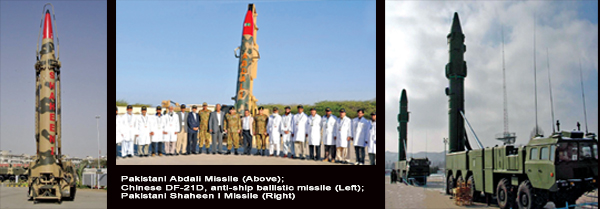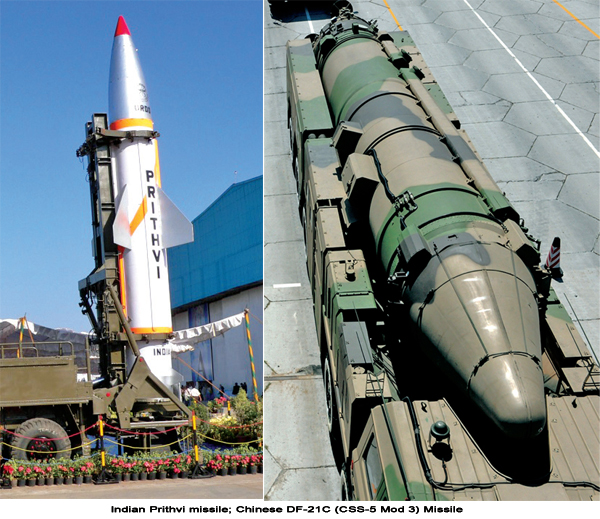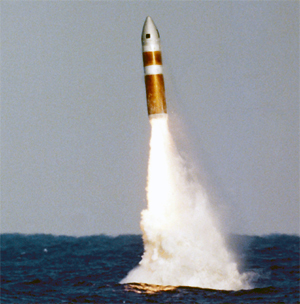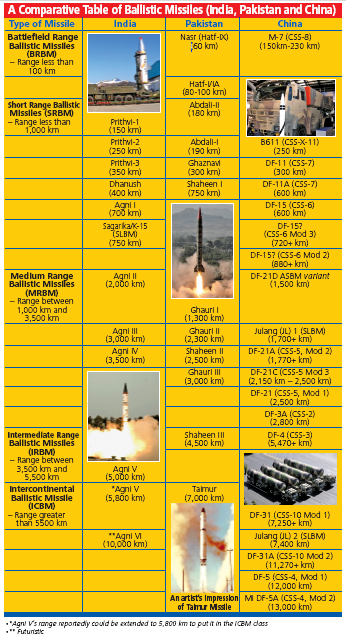|
In India, the success of the launch was received
with much acclaim with Prime Minister Manmohan
Singh congratulating all the scientific and technical
personnel of the DRDO and other organisations
for their tireless endeavours resulting in the
outstanding achievement. “Agni V test launch
represents another milestone in our quest to add
to the credibility of our security and preparedness”,
he asserted.
The Indian media, as was to be expected, went
in a frenzy giving the Agni V the sobriquet of
“China Killer” because of its reach.
In a way, the solid-fuel Agni V with an initial
range of 5,000 km that will likely to be extended
to over 5,500 km, will not only put it in the
category of a true Inter-Continental Ballistic
Missile (ICBM) but, also give it the capability
of reaching the northern parts of China when launched
from the farthest north-eastern parts of India.
The then DRDO Chief Dr Saraswat himself called
the missile a “Game-changer”.

This reality was obviously not lost on Beijing
as was evident from its response. There were in
fact two strains of differing responses that emanated
from the mouth-pieces of China. On one hand, the
semi-official Global Times claimed India was a
“cooperative partner” and advised it
to “cherish the hard won momentum of sound
bilateral relations.” In the same breath,
though, India was also counseled not to harbour
any “missile delusion” from what was
described as a “dwarf missile” and not
to “overestimate its strength” since
“China’s nuclear power is stronger and
more reliable.”
Clearly, this could hardly be construed as a
veiled warning, brazen as it was in its intent
and content. This was also a strong reminder for
the over-hyped Indian media to face the realities
as they exist.
China’s military undoubtedly has the world’s
most active and diverse ballistic missile programme
which it has been pursuing ever since it exploded
its first nuclear weapon device in the 1960s.
Its ballistic missile arsenal includes different
types of missiles with ranges covering the entire
spectrum from battlefield/short range to intercontinental
ranges of up to 13,000 km. China continues to
expand its missile programme under a broader military
modernisation plan that has seen the country’s
defence spending more than double since 2006.
China’s missile arsenal includes a new submarine-launched
JL-2 ballistic missile that will for the first
time let Chinese submarines target part of the
US from near China’s coast. In addition,
its DF-21 is designed as an A2AD (Anti-Access
Area Denial) weapon with a range of around 2,500
km specifically against an aircraft carrier naval
task force. The implications of this sort of capability
should be obvious to India for its land-based
assets in the country and island territories and
the naval forces even in the so-called home waters
(IOR- Indian Ocean Region).

China, a profligate proliferator of nuclear
arms and missiles, is also known to create proxy
states and prepare them to do its bidding when
required. Take the case of Pakistan where China
not only helped it in developing the nuclear weapons
but also supplied delivery systems in the form
of different types of missiles with varied ranges.
Pakistan, of course, cleverly disguised most of
the missile programmes as its own by giving the
missiles different Islamic names. For example,
the first of Pakistan’s larger missile systems,
the Hatf III ‘Ghaznavi’ with a range
of 600 km and payload of 500 kg, first tested
in July 1997, was claimed by Pakistan as a major
break-through in its missile building capabilities.
It has a two-stage solid fuel rocket motor and
a more advanced terminal guidance system with
an on-board computer. Five different types of
warheads have been designed for the missile and
they can be delivered with a claimed Circular
Error Probability (CEP) of 0.1% at 600 km. But,
it is a well known fact that Ghaznavi is none
other than the Chinese M-11 missile. Similarly,
Ghauri and Shaheen series of missiles are believed
to have been basically acquired from China, painted
slightly differently from the original Chinese
missiles and claimed with much fanfare as Pakistan’s
own. The Ghauri series are liquid-fuelled ballistic
missiles whose development was known to be headed
by the Kahuta Research Laboratories (KRL). Similarly,
the Shaheen series are solid-fuelled ballistic
missiles ostensibly developed by the National
Development Complex (NDC), which was founded by
the Pakistan Atomic Energy Commission. It is well
known that these programmes, especially the one
involving the development of Shaheen series missiles
was highly ambitious considering Pakistan’s
lack of infrastructure. Even then two Shaheen
variants are known to have been completed and
made operational, the Shaheen-I and Shaheen-II.
The still under development Shaheen-III IRBM (Intermediate
Range Ballistic Missile) with a range of 4,500
km range will also be ready for operational deployment
soon, as claimed by the Pak authorities. If that
was not audacious enough, Pakistan has also unveiled
another highly ambitious programme to develop
a true-blood ICBM (Inter Continental Ballistic
Missile) with a range in excess of 7,000 km.
 India
on the other hand, had to start from a scratch
in its quest for developing its missile systems
to provide the necessary deterrence against its
two nuclear-armed neighbours. Prithvi and Agni
series missiles are the result of painstaking
research spanned over three decades as part of
the overall Integrated Guided Missile Development
Programme (IGMDP). India
on the other hand, had to start from a scratch
in its quest for developing its missile systems
to provide the necessary deterrence against its
two nuclear-armed neighbours. Prithvi and Agni
series missiles are the result of painstaking
research spanned over three decades as part of
the overall Integrated Guided Missile Development
Programme (IGMDP).
The latest in the ‘Agni’ series, Agni
V with a 5,000 km+ range is scheduled for two
more tests, success of which will determine as
to when the missile could be inducted into operational
service. Interestingly, the latter of the two
tests will see the 50-tonne Agni V being fired
from a hermetically-sealed canister mounted on
a launcher truck.
“We are getting ready for two more tests
of the three-stage Agni V this year, which will
include the canister-launch trial. Our aim is
to make the missile ready for induction in two
years”, said the recently appointed DRDO
chief, Dr Avinash Chander – also the Chief
Architect of the Long Range Ballistic Missile
System ‘Agni’.
It is noteworthy that while along with the Prithvi
series the Pak-specific Agni I (700 km), Agni
II (2,000 km+) and Agni III (3,000 km) have been
inducted into the armed forces but even Agni IV
with a strike range of 3,500 km is yet to enter
operational service. Therefore, India could hardly
boast of any worthwhile deterrence capability
against China till the Agni IV and Agni V get
operational (planned inductions, end-2014 and
2015, respectively).
 With
a massive nuclear arsenal and missiles like the
11,200 km+ Dong Feng, DF-31A capable of hitting
any Indian city, Beijing is leagues ahead of New
Delhi (see accompanying table for a comparison
of the ballistic missiles of India, China and
Pakistan). With
a massive nuclear arsenal and missiles like the
11,200 km+ Dong Feng, DF-31A capable of hitting
any Indian city, Beijing is leagues ahead of New
Delhi (see accompanying table for a comparison
of the ballistic missiles of India, China and
Pakistan).
India and especially its media should be cautious
not to get into overdrive over its yet to be achieved
operational capabilities vis-à-vis China.
On the other hand, India needs to accelerate its
Agni IV and V programmes to create at least the
minimum deterrence capabilities against China.
The planned canister-launch system for Agni
V would give the forces the requisite operational
flexibility to swiftly transport the ballistic
missile and launch it from a place of their own
choosing. It will also bring in a much needed
2nd strike capability when viewed against India’s
declared ‘No-First Use’ doctrine. But,
this by itself will not be sufficient to create
a credible nuclear deterrence.
According to Dr Chander, “After these two
missiles (Agni IV and Agni V) are inducted, the
two major focus areas will be manoeuvring warheads
or re-entry vehicles to defeat enemy ballistic
missile defence systems and MIRVS (Multiple Independently
Targetable Re-entry Vehicles). An MIRV payload
implies a single missile carrying several warheads,
each programmed to hit different targets.
In the long run, India would also have to create
the necessary ‘reach’ capabilities to
fully cover the Chinese territory from any part
of India, including its southern regions. Therefore,
as Chander says while “there is no Agni VI
programme as of now”, at some stage, development
of the 10,000 km + Agni VI (or ‘Surya’?)
ICBM may become a strategic necessity for India.
Till then, India would do well to “Keep
a cool head and maintain a low profile. Never
take the lead - but aim to do something big”,
as postulated by the former Chinese President,
Deng Xiaoping in the 1980s, when China embarked
upon its own military modernisation programme.
|